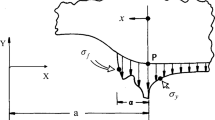Abstract
Steady state crack propagation in solids is analyzed as a thermally activated process. The fracture mechanics concept of a crack driving force is formally introduced to molecular rate theory. This representation of crack propagation appears to be, in many aspects, similar to that of the motion of a dislocation under a shear stress across thermal obstacles. The basic thermodynamic relations are derived for steady state crack propagation using assumptions similar to those well accepted in theories of deformation based on thermally activated dislocation motion.
Résumé
La propagation stationnaire d'une fissure dans un solide est analysée en tant qu'un processus d'activation thermique. Le concept d'une force d'extension de la fissure, utilisé en mécanique de la rupture, est formellement introduit dans la théorie cinétique moléculaire. Cette représentation de la propagation d'une fissure apparaît, en maint aspects, similaire à celle du mouvement d'une dislocation sous l'effect d'une contrainte de cisaillement à traver des obstacles thermiquement franchissables. On dérive les relations thermodynamiques fondamentales pour la propagation stationnaire d'une fissure, à partir d'hypothèses simplificatrices similaires à celles couramment acceptées dans les théories de déformation basées sur le mouvement thermiquement activé des dislocations.
Similar content being viewed by others
References
G.R.Irwin, in Handbuch der Physik, Springer-Verlag, Berlin, 6 (1958) 551.
E.Orowan, Weld. Res. Supp., 34 (1955) 157.
A.Tobolsky and H.Eyring, Journal of Chemical Physics, 11 (1943) 125.
S.N.Zhurkov, International Journal of Fracture Mechanics, 1 (1965) 311.
H.H.Kausch von Schmeling, S.R.Moghe and C.C.Hsiao, Journal of Applied Physics, 38 (1967) 201 and Journal of Applied Physics, 39 (1968) 3857.
R.J.Charles, Journal of Applied Physics, 29 (1958) 1554 and Journal of Applied Physics, 29 (1958) 1657.
W.B.Hillig and R.J.Charles, in High-Strength Materials, V.F.Zackey, ed., John Wiley and Sons, Inc., New York (1965) 682.
C.Hsieh and R.Thomson, Journal of Applied Physics, 44 (1973) 2.
B.Coleman, Journal of Polymer Science, 20 (1956) 447.
S.M.Wiederhorn, H.Johnson, A.M.Diness and A.H.Hever, Journal of the American Ceramic Society, 57 (1974) 336.
S.M.Wiederhorn, Journal of the American Ceramic Society, 50 (1967) 407.
A.G.Evans and S.M.Wiederhorn, Journal of Material Science, 9 (1974) 270.
S.M.Wiederhorn and L.H.Bolz, Journal of the American Ceramic Society, 53 (1970) 543.
J.A. Kies and A.B. Clark, Proceedings of the Second International Conference on Fracture, Brighton, (1969) paper 42.
A.G.Atkins, C.S.Lee, R.M.Caddell, Journal of Material Science, 10 (1975) 1381.
C.B.Henderson, P.H.Graham and C.N.Robinson, International Journal of Fracture Mechanics, 6 (1960) 33.
W.G. Knauss, Applied Mechanics Reviews (Jan. 1973).
A.G.Evans, Journal of Material Science, 7 (1972) 1137.
J.C.M. Li and A.K. Mukherjee, eds., Rate Processes in Plastic Deformation of Materials, A.S.M. (1975).
J.C.M. Li, in Dislocation Dynamics, Materials Science and Engineering Series, Rosenfield et al., eds., McGraw-Hill (1968) 87.
B. de Meester, C. Yin, M. Doner and H. Conrad, in Ref. [19], 175.
J.C.M.Li, Acta Metallurgica, 18 (1970) 1099.
J.C.M. Li, in Ref. [19], 479.
A.J.Holland and W.E.S.Turner, Journal of the Society of Glass Technology, 24 (101) (1940) 46–57 T.
E.B.Shand, Journal of the American Ceramic Society, 37 (1954) 52.
G.P. Marshall, L.E. Culver and J.G. Williams, Plastics and Polymers, (Feb. 1969) 75.
J.N.Obreimov, Proceedings of the Royal Society (London), A127 (1930) 290.
A.Seeger, Zhurnal Naturforsch, 9a (1954) 758, 819, 856.
Author information
Authors and Affiliations
Rights and permissions
About this article
Cite this article
Pollet, J.C., Burns, S.J. Thermally activated crack propagation — theory. Int J Fract 13, 667–679 (1977). https://doi.org/10.1007/BF00017299
Received:
Revised:
Issue Date:
DOI: https://doi.org/10.1007/BF00017299




